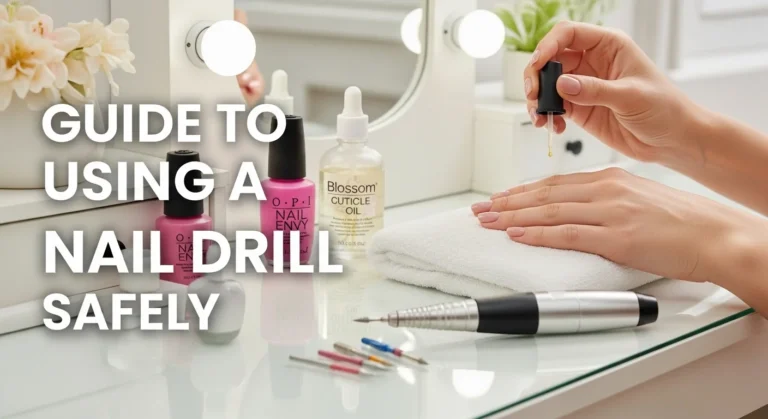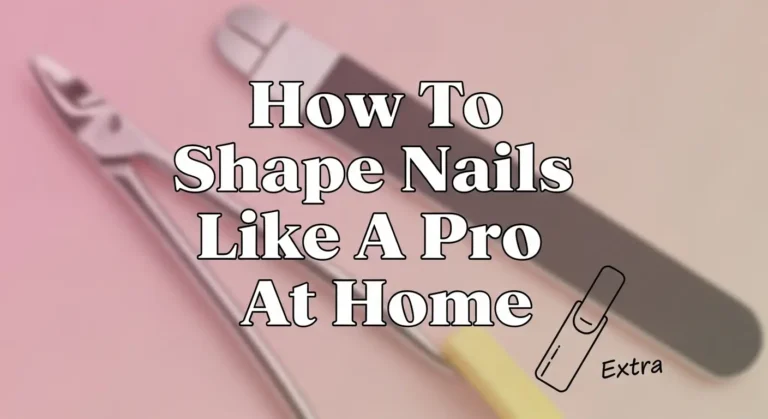Easy At-Home Routine for Stronger, Healthier Nails
A simple, consistent at-home nail care routine can strengthen weak nails, prevent breakage, and improve overall nail health. Focus on daily moisture, gentle filing, nutrient-rich care, and protective habits.
A steady at-home nail routine based on moisture, protection, and balanced nutrition strengthens nails over time. Small, consistent habits, like moisturizing daily and trimming weekly, create noticeable improvements in nail durability and appearance.
If your nails frequently split or peel despite regular care, explore practical recovery steps in our detailed guide on fixing brittle nails that snap too easily.
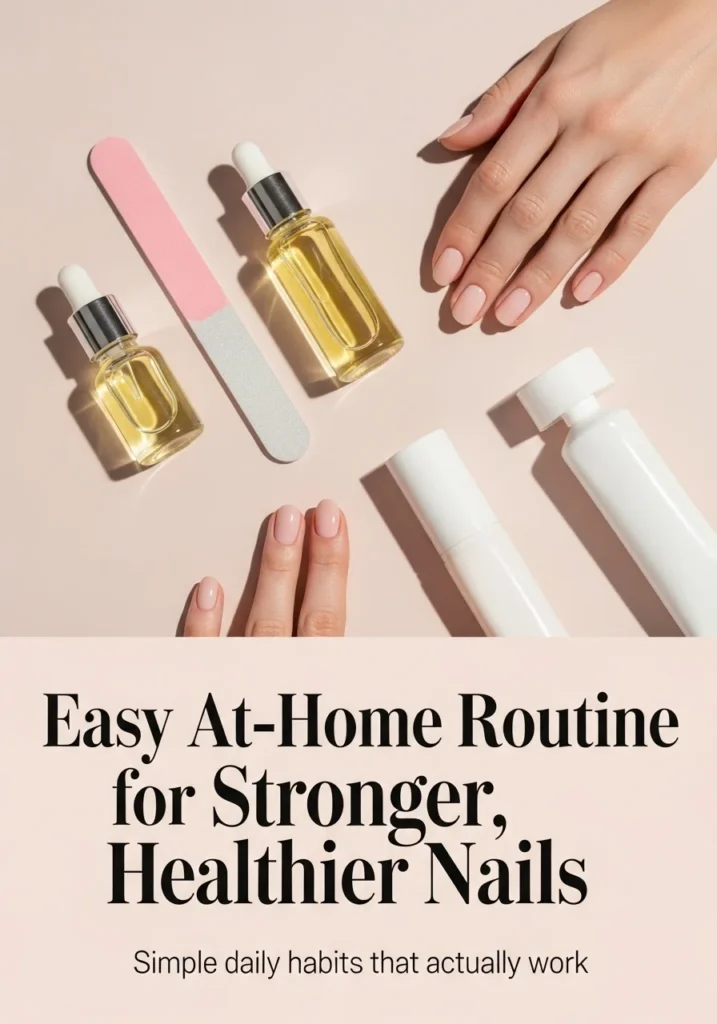
Key Nail Care Practices
| Routine Step | Frequency | Benefit |
|---|---|---|
| Moisturize cuticles | Daily | Prevents dryness and hangnails |
| Trim & file | Weekly | Keeps nails strong and even |
| Use gloves | As needed | Shields from water and chemicals |
| Balanced diet | Daily | Supports healthy growth |
| Gentle buffing | Monthly | Smooths nail surface |
Easy At-Home Routine for Stronger, Healthier Nails
Healthy nails rely on moisture, protection, and balanced nutrition. With a few minutes of care each day, you can maintain stronger, smoother nails without salon treatments.
Quick Nail Facts:
- Nails grow 2–3x slower than fingernails on the dominant hand.
- Nail polish doesn’t cause yellowing — trapped oils or UV exposure do.
- 1 teaspoon of olive oil massage daily can increase nail flexibility by 10%.
Why Nail Strength Weakens
Common Causes of Weak or Brittle Nails:
- Frequent exposure to water or harsh detergents
- Nutrient deficiencies (e.g., biotin, iron, zinc)
- Overuse of acetone-based removers
- Aging or hormonal changes
- Repeated acrylic or gel application without rest
| Cause | Effect on Nails | Simple Fix |
|---|---|---|
| Excessive moisture | Soft, peeling edges | Dry thoroughly and moisturize after washing |
| Harsh chemicals | Dryness, breakage | Wear gloves during cleaning |
| Nutrient gaps | Slow growth, brittleness | Add biotin, iron, and protein to diet |
| Acetone removers | Dehydration | Use acetone-free removers |
| Frequent salon treatments | Weak nail bed | Allow recovery periods |
If you struggling with slow growth, our research-based article on boosting slow nail growth naturally explains how nutrients, hydration, and lifestyle habits directly influence nail length and resilience.
Step-by-Step: Daily & Weekly Nail Care Routine
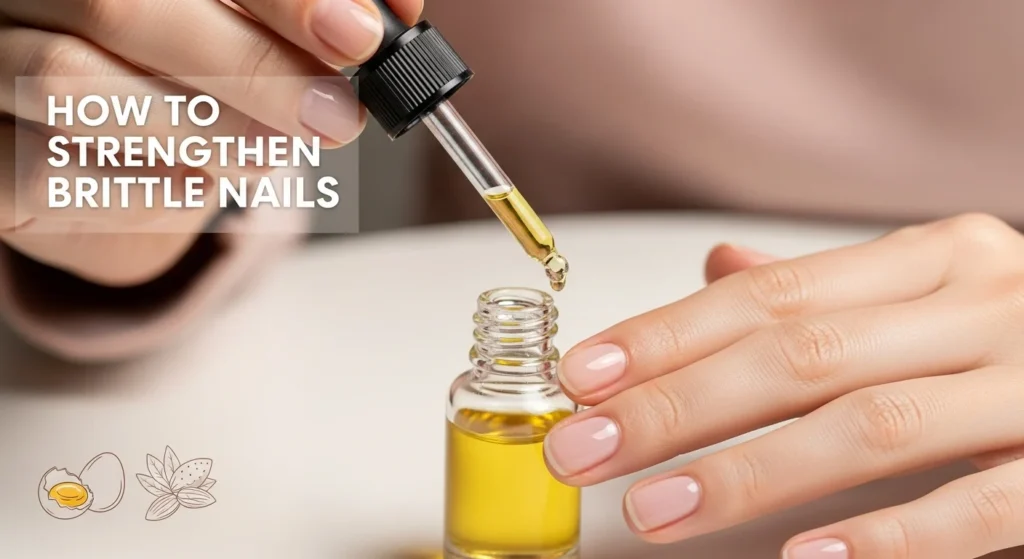
1. Keep Nails Clean and Dry
- Wash hands regularly but avoid soaking nails for long periods.
- After washing, dry thoroughly, including under the nail edge.
- Moisture trapped under nails can lead to peeling or bacterial growth.
2. Moisturize Cuticles and Nails
- Apply cuticle oil or hand cream daily, especially before bed.
- Look for ingredients like jojoba oil, vitamin E, or shea butter.
- Massage gently to boost circulation and nail growth.
3. Trim and File Regularly
- Trim nails once a week to maintain shape and prevent snagging.
- Use a fine-grit file, moving in one direction only.
- Avoid metal files, which can split the nail layers.
4. Limit Nail Polish Remover Use
- Use acetone-free remover no more than once or twice weekly.
- If using gel or acrylics, take breaks between sets to let nails recover.
5. Protect Nails from Damage
- Wear rubber gloves when cleaning or washing dishes.
- Avoid using nails as tools to open or scrape items.
- Keep nails short if they chip easily.
6. Maintain a Balanced Diet
Nail health reflects overall nutrition. Key nutrients include:
| Nutrient | Role in Nail Health | Food Sources |
|---|---|---|
| Biotin | Strengthens nail structure | Eggs, almonds, sweet potatoes |
| Iron | Prevents brittle, spoon-shaped nails | Spinach, lentils, lean meats |
| Zinc | Aids repair and growth | Pumpkin seeds, chickpeas |
| Vitamin E | Protects nail cells | Avocado, sunflower seeds |
| Protein | Supports keratin production | Fish, tofu, beans |
7. Buff Sparingly
- Light buffing can smooth ridges but overdoing it thins nails.
- Use once a month, gently, and follow with moisturizer.
If your nails feel thin or fragile after frequent gel or acrylic use, follow this step-by-step guide to recovering from gel or acrylic damage to help restore strength safely at home.
Weekly Nail Mask or Soak (Optional)
Simple DIY Nail-Strengthening Soak:
Ingredients:
- 1 tablespoon olive oil
- 1 teaspoon honey
- Few drops of lemon juice
Instructions:
- Mix ingredients in a small bowl.
- Soak nails for 10–15 minutes.
- Rinse and apply hand cream.
This natural blend helps moisturize, brighten, and fortify nails.
🧮 Nail Health by the Numbers
Quick Stats on Nail Strength and Care Habits
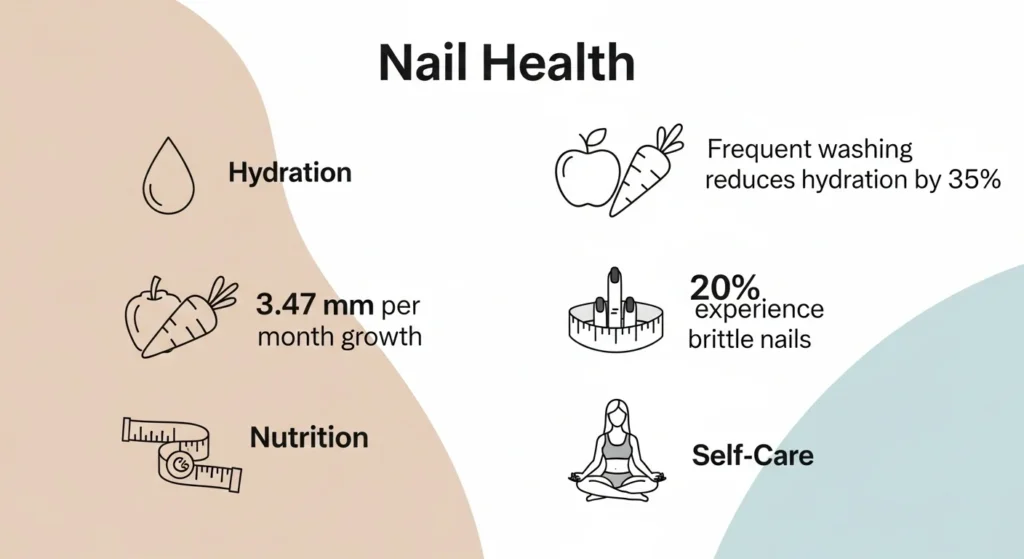
Adding measurable insights helps readers understand what actually affects nail health. These figures are drawn from dermatology and cosmetic science studies:
- 3.47 mm per month — average nail growth rate (Journal of Cosmetic Dermatology).
- 20–25% of adults experience nail brittleness at some point, often due to dehydration or aging (American Academy of Dermatology).
- Biotin deficiency may contribute to weak nails in about 1 in 5 women, though true deficiency is uncommon.
- Frequent handwashing can reduce nail hydration by up to 35% if moisturizer isn’t used afterward.
- Acetone-based removers increase nail brittleness by 25–30% compared to acetone-free formulas.
- 60% of nail damage is related to external habits like over-filing, harsh chemicals, or nail biting, rather than internal health factors.
Tip: Understanding these small factors — such as exposure to detergents and water — is more important than relying on supplements alone for nail health.
Keeping cuticles hydrated is essential for overall nail health — our guide on taming dry, cracked cuticles shares dermatologist-backed hydration methods to prevent splits and hangnails.
🌦️ Seasonal Nail Care Adjustments
How Weather Affects Nail Health — and What to Do About It
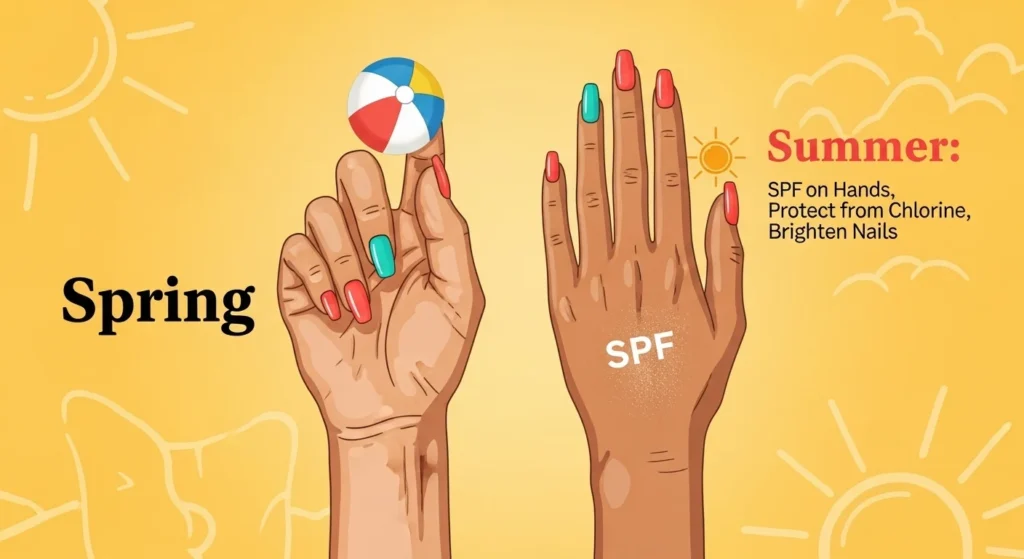
Nails respond differently to seasonal changes in humidity and temperature. Adjusting your care routine slightly each season helps prevent brittleness, peeling, and discoloration.
| Season | Common Nail Challenge | Recommended Care Routine |
|---|---|---|
| Winter | Dryness, cracking, dull texture | Use thicker hand creams, apply cuticle oil twice daily, wear gloves outdoors. |
| Spring | Peeling or flaking from cold recovery | Introduce hydrating oils, gently buff ridges, and start biotin-rich foods. |
| Summer | Yellowing, dehydration, UV exposure | Apply SPF to hands, avoid long sun exposure with polish, use light cuticle oils. |
| Fall | Fungal buildup due to humidity | Keep nails clean and dry, disinfect tools weekly, and avoid tight gloves. |
Observation: Humidity and cold both affect nail keratin differently, cold reduces flexibility, while humidity promotes bacterial growth. Seasonal care reduces these risks naturally.
🧠 Nail Myths vs. Facts
Common Misconceptions About Nail Care Explained Clearly

| Myth | Fact | Why It Matters |
|---|---|---|
| “Nails need to breathe.” | Nails don’t absorb oxygen; they get nutrients from blood flow under the nail bed. | Prevents unnecessary polish-free “breathing” breaks. |
| “Cutting cuticles helps nails grow faster.” | Cuticles protect new nail cells from infection; cutting them can cause inflammation. | Focus on moisturizing instead of trimming. |
| “White spots mean calcium deficiency.” | Usually caused by minor trauma or pressure, not low calcium. | Avoid harsh buffing or pressing on nails. |
| “Gel polish always damages nails.” | Improper removal, not the polish itself, causes damage. | Use acetone wraps and avoid scraping. |
| “Nail hardeners strengthen weak nails.” | Overuse can make nails brittle by reducing flexibility. | Use short-term only, then switch to moisturizers. |
Insight: Correcting small misconceptions often improves nail health faster than adding new products or supplements.
Common Queries About Nail Health
How fast do nails actually grow, and when will I see improvement?
- Fingernails grow on average ≈ 3.47 mm per month; toenails grow more slowly.
- With consistent care (moisturizing, reducing harsh exposure, good nutrition), visible improvement in strength and reduced breakage can show up in 4–6 weeks. Full regrowth or recovery (if damage is deeper) may take several months.
Does biotin really help strengthen nails? Is there scientific support?
- Some studies show biotin (a B vitamin) improves nail thickness and reduces brittleness in individuals who are deficient.
- For people without deficiency, the effects are less certain. It may help somewhat, but other factors (diet, hydration, protection) are often as or more important.
Why do my nails peel, split, or break even though I moisturize regularly?
Several causes can still lead to peeling or splitting despite moisturizing:
- Repeated exposure to water or harsh detergents, especially without wearing gloves.
- Overuse of acetone-based polish removers. They strip natural oils.
- Nutrient deficiencies (e.g., iron, zinc, protein).
- Underlying health conditions (thyroid issues, anemia, etc.).
Can nail care products like hardeners or polish hurt nails if used too much?
- Yes. Nail hardeners can help in the short term, but overuse (or using strong formulas without breaks) may make nails more brittle by reducing flexibility.
- Polish removers with strong solvents (especially acetone) dry out the nail plate and can weaken it if used frequently.
What lifestyle or diet changes make the biggest difference for nail strength?
Key changes that tend to show noticeable benefits:
- Eating a balanced diet with enough protein, iron, zinc, vitamins A, C, E, and biotin.
- Staying hydrated—both by drinking enough water and by protecting nails from drying factors (e.g. frequent handwashing, dry climate).
- Protecting nails during chores (using gloves), limiting harsh chemical exposure, giving nails a break from frequent polish or acrylic/gel use.
When should I see a doctor about nail problems?
Consider consulting a dermatologist if:
- Nail issues persist despite good routine for several months.
- You observe signs like yellowing, thickening, or deformities (e.g., spoon-shape nails).
- Other symptoms appear (skin changes, fatigue, hair loss)—as these may indicate an underlying medical issue like thyroid disease or anemia.
Step-by-step tutorials & how-to guides for nail care pros and beginners
Pro Beauty Chic Tutorials & How-To

